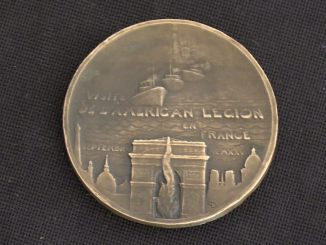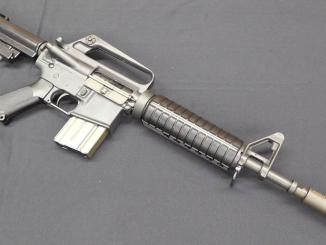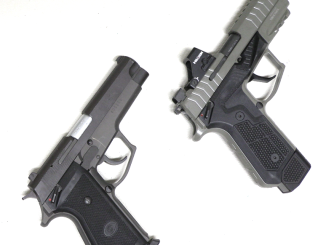During World War Two, the OSS (Office of Strategic Services) was the primary US clandestine operations organization. It was responsible for making all sorts of unique weapons, including these “Stinger” cigarette guns. They were single shot disposable .22 Short pistols.
The first pattern was contracted and manufactured entirely by the OSS, and 25,000 of them were manufactured early in the war. They proved to have a myriad of minor to moderate problems, though, including failures to fire and burst barrels. A second version was produced by the Ordnance Department in 1944, with a strengthened and improved design, and 25,500 of those were made.
I have not found any documentation of these being actually used, but then again not much documentation exists on the use of any OSS weapons. These sorts of things were often provided to infiltration agents who might never be heard from again, or dropped to partisan or resistance groups who weren’t exactly writing field reports on their gear.




The OSS Stinger was primarily used as a hideout weapon. The idea being that having even as primitive and low-powered a gun as this was better than nothing at all, especially if you were captured.
The OSS manual states that the Stinger should normally be hidden in the crotch, pointed downward, inside your BVDs. The reason being that except in a strip search, it was unlikely to be found, because due to cultural factors German and French (Vichy) police would rarely “feel up” a gent’s family jewels, or a lady’s “unmentionables”.
As to its use, the drill was when you and a guard were alone, grab him from behind as though you were performing a knife attack, stick it in the back of his neck just as you would use a knife, and fire it upward into his brain stem. His own flesh would muffle the shot and in this way even the low-powered .22 Short would almost guarantee an instant kill. Then take his uniform and weapon and casually walk away.
Well, that’s what the book said. In fact, the most common use of the Stinger was as a booby-trap trigger. There were numerous ways it could be so used, one of the most common being to tape a non-electric (i.e., fulminate-type)blasting cap into its barrel attached to a short piece of detonating cord (“det cord” or Primacord- the latter the Ensign Bickford trademark name for the stuff) and stick the other end into a block of PE (plastic explosive).
Then set the bomb anywhere you wanted a bang, with the Stinger wedged, taped, or etc. in such a way that someone opening a door, stepping on it, etc, would depress the “trigger” and fire it. Firing the cap, the det cord, and the PE block.
It was especially favored as a method of boobytrappng vehicles, either with the Stinger and PE under the driver’s seat (sit down on it and BOOM) or with the Stinger rigged to one of the pedals (gas, brake or clutch) and the PE block up under the dashboard or attached to the front of the firewall (press a pedal and, again, BOOM).
While not much of a gun, the Stinger was an effective sabotage device. Which suited the OSS’ operating methods very well indeed.
cheers
eon
“use of the Stinger was as a booby-trap trigger.”
Well, in fact various triggers of that era have similar shape, although it was caused by how they functioned, not need to disguise. Examples are British Switch, no. 10, Delay dubbed by SOE operators time pencil
http://www.timelapse.dk/timepencil.php
However as name imply it will fire after given time after activation (for example 12 hours), though as usage show amount of time between activation and “bang” was far from exact, varying depending on free air temperature.
Most popular trigger for explosive devices used by Soviet forces during Great Patriotic War was МУВ (минный универсальный взрыватель, [land]mine universal fuse), see images here: http://army.lv/ru/muv/1478/3177
images from top to bottom:
1. cut-away drawing: 1) hole for cocking pin [present only in early production model] 2) hole for safety pin 3) cotter pin 4) striker 5) body 6) spring 7) igniter
2. clock-wise, from top left: “P” cotter pin, “T” cotter pin, safety pin
3. from left to right: old pattern fuse with cocking pin, old pattern fuse with “P” cotter pin, new pattern fuse with “T” cotter pin
4. disassembled fuse
5. igniters, first from left has two threads, one fitting into fuse and another into landmine
6. usage example, 1) stick 2) fuse 3) wire 4) explosive
7. variant of fuse with plastic body
The Chinese closed captioning ln yellow bands obscures a large portion of the screen. please remove! Ha I’ll bet you didn’t know you had it.
I see no yellow bands, but the CC is in Chinese here also. Past Forgotten Weapons Closed Captions have been in Russian, Korean, etc., following particular videos here. I don’t know what happens to cause that.
Hmmm. What Chinese websites have you been surfing lately?
None that I know of. But these days, you can never be sure. 🙂
Just click the ‘cc’ box in the bottom of the vid screen. They dissapear.
I don’t want them to disappear… I want them in ENGLISH.
select “settings” (the little flower-shaped icon) and change the subtitles/CC to “english auto-generated”
Thanks! I had tried this before on other FW videos and it didn’t work. But it worked on this one, for some reason. 🙂
It seems to me that these would barely be lethal even if you pressed them against the head of the victim and fired. A simple “Penguin” pen gun with a .32 ACP barrel would only be slightly larger (as well as reloadable). Or issue a disposable screw on bullet firing cartridge like the flare and tear gas cartridges the pen gun usually fired.
How about jabbing the device into the victim’s eye socket?
the reason for the shot up into the brain from the back of the neck as that above the spinal/brain stem juncture and below the back of the skull it’s mostly just soft tissue, with very little bone in the way.
I’m not sure that a .22 Short into the eye from a barrel that short would have enough velocity to inflict a critical wound on the target. The eye socket is actually a fairly tough piece of anatomy in back.
You might kill him, but maybe not fast enough to keep him from killing you.
That might be yet another reason for the “field expedient” use of the little beasts as triggering devices. At least that way, you don’t have to be around when the critter goes off.
cheers
eon
Any future reports on OVERT cigarette guns?
Google “pen gun”. Improvised and factory built ones have been the bane of law enforcement worldwide for decades.
Improvised ones ranging from .22 on up to .38 have been used almost everywhere, usually as hideout weapons by professional criminals. Being improvised, they’re not really traceable like a “store-bought” gun.
Blackmailers in Canada used to like to use them to shoot a “mark” in the leg on the street to “encourage” him to pay up.
And such improvised guns have always been typical of the types made in prison by cons for use in escape attempts. To say nothing of those who make them looking to “enforce” their control of others, or ones seeking to resist such “enforcement”.
The reason convicts want such small, concealable weapons is pretty obvious. And for their purposes, one shot, even a dinky .22 Short, is often more than enough.
cheers
eon
“Improvised ones ranging from .22 on up to .38 have been used almost everywhere, usually as hideout weapons by professional criminals.”
The Chessboard Killer who was active in Moscow: https://en.wikipedia.org/wiki/Alexander_Pichushkin
is known to use pen gun, though it was not his preferred method
I’d regard this to be a loud, one-stab “knife” even though the reach is beyond arm’s length. Due to low power and the lack of sights, it looks as if the cigarette gun would be most effective when the muzzle is pressed against the enemy’s head. Just don’t try to qualify on a modern police service pistol course with the pen gun. People will laugh.